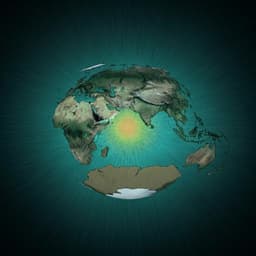
Earth Sciences
Tropical volcanism enhanced the East Asian summer monsoon during the last millennium
F. Liu, C. Gao, et al.
This research reveals the surprising link between extreme East Asian summer monsoon rainfall and strong tropical volcanic eruptions. The findings suggest that the first summer after such eruptions sees intensified rainfall, potentially leading to floods, as explored by the authors Fei Liu, Chaochao Gao, Jing Chai, Alan Robock, Bin Wang, Jinbao Li, Xu Zhang, Gang Huang, and Wenjie Dong.
~3 min • Beginner • English
Introduction
The study addresses how tropical volcanic eruptions influence the East Asian summer monsoon (EASM). While prior modeling suggested volcanic aerosols reduce surface shortwave radiation and suppress the global hydrological cycle, implying weakened EASM, historical observations and chronicles do not consistently show post-eruption drought over East Asia. Because EASM rainfall is strongly modulated by El Niño, the authors hypothesize that volcano-induced changes in ENSO may enhance EASM precipitation despite overall cooling. They investigate whether tropical eruptions increase the likelihood of El Niño and thereby intensify EASM rainfall in the first post-eruption summer, clarifying the interplay between external volcanic forcing and internal climate variability.
Literature Review
Previous studies found suppressed EASM after eruptions in models due to hydrological weakening from reduced shortwave radiation. Case studies after the 1815 Tambora and the 1982/1991 eruptions did not show significant East Asian drought, questioning universal suppression. Multiple proxy reconstructions indicate an increased likelihood of El Niño after tropical eruptions, with proposed mechanisms including the ocean dynamic thermostat and land–sea thermal contrast that reduce the equatorial Pacific SST gradient and weaken the Walker circulation via Bjerknes feedback. ENSO’s strong control on EASM via the western North Pacific subtropical high and associated moisture transport suggests that ENSO changes must be accounted for when assessing volcanic impacts on EASM.
Methodology
The authors combine multi-proxy reconstructions with multi-model simulations. Proxy analyses use a gridded (0.5°×0.5°) May–September precipitation reconstruction over Asia (1470–1999) and two additional independent reconstructions over China and Asia for confirmation. ENSO variability is represented by the ensemble mean of 11 reconstructed ENSO indices: each series is 9-year Lanczos high-pass filtered, normalized, and then averaged annually to reduce proxy uncertainty. El Niño events are defined when boreal winter Niño3.4 exceeds +0.5 standard deviations. Twenty-two precisely dated tropical eruptions (Sigl et al. 2015) from 1470–1999 are composited using superposed epoch analysis (SEA), with anomalies computed relative to the 5-year pre-eruption climatology and significance assessed via bootstrap resampling (10,000 draws) over an 11-year window (−5 to +6 years). Climate simulations include 13 last-millennium PMIP3/PMIP4 models and 10 CESM-LME ensemble members. Eruptions are identified per each model’s volcanic forcing dataset; year 0 is the year of peak annual mean stratospheric sulfate aerosol. A total of 92 PMIP events (1470–1849) and 228 events (850–1849) are analyzed, with composites stratified by presence/absence of a preceding El Niño. EASM metrics include an EASM region mean precipitation (25°–34°N, 106°–122°E) and an EASM circulation index defined as the 850-hPa zonal wind difference between northern (22°–32°N, 130°–160°E) and southern (9°–19°N, 120°–150°E) boxes, where a negative index denotes an enhanced Pacific High and stronger EASM. Precipitation changes are decomposed into dynamic (circulation-related) and thermodynamic (moisture-related) components via moisture convergence diagnostics, with nonlinear terms assumed smaller. Statistical significance for model fields uses 90% confidence thresholds.
Key Findings
- Proxy composites show that in the first boreal summer after tropical eruptions (1470–1999), East Asia exhibits significantly positive precipitation anomalies centered on the Yangtze River basin, northeast China, and Kyushu, with significance at or above the 90% level. Regionally averaged EASM precipitation over 25°–34°N, 106°–122°E shows significant positive anomalies at the 95% level only in the first post-eruption summer.
- The ENSO-conditioned proxy analysis indicates that enhanced EASM rainfall after eruptions occurs when an El Niño is present in the first post-eruption winter; eruptions without a preceding El Niño show near-normal EASM anomalies. Volcano-induced El Niño cases produce stronger EASM enhancement than non-volcanic El Niños.
- In reconstructions, the fraction of El Niño occurrences after tropical eruptions is elevated: 41% for 1470–1999 and 44% for 901–1999, versus an expected 27% for non-volcanic years.
- Multi-model PMIP composites of 92 preindustrial eruptions show a relative El Niño signal (reduced equatorial Pacific zonal SST gradient) in the first post-eruption winter. In the first post-eruption summer, models simulate Indo-Pacific cooling and Asian drying, with small but significant positive precipitation over the middle–lower Yangtze and a significantly negative EASM circulation index (enhanced Pacific High), indicating strengthened EASM circulation.
- Stratifying model events reveals that 65 eruptions without a preceding El Niño yield cooling and drying with weak El Niño-like SST gradients and insignificant EASM change, whereas 27 eruptions with a preceding El Niño produce significant EASM precipitation increases over the Yangtze region driven by southwesterly anomalies of an enhanced Pacific High and extratropical northerlies.
- Dynamic–thermodynamic decomposition shows that after eruptions the dynamic component of EASM precipitation increases while the thermodynamic component decreases (cooling-induced moisture deficit); total changes are small unless an El Niño occurs, which boosts the dynamic component without substantially altering the thermodynamic reduction.
- Across 92 model events, post-eruption EASM precipitation change correlates with preceding El Niño amplitude (r=0.19, 90% level), and the EASM circulation index shows a stronger correlation (r=−0.44, 99% level), indicating that stronger El Niño events yield larger EASM enhancement.
- PMIP models produce El Niño after eruptions less frequently (29%) than reconstructions, consistent with a weaker composite rainfall response and potentially reflecting muted coupling between central Pacific convection and westerly wind anomalies.
Discussion
Findings demonstrate that tropical volcanic eruptions can intensify EASM rainfall in the first subsequent summer when they trigger El Niño, with Pacific warm pool air–sea feedbacks enhancing the western North Pacific subtropical high and moisture convergence over East Asia. This dynamic enhancement can outweigh the thermodynamic drying expected from volcanic cooling, reconciling discrepancies between hydrological weakening theory and observed post-eruption East Asian hydroclimate. The elevated probability of El Niño after eruptions in reconstructions explains the net positive EASM signal in proxy composites. Model ensembles reproduce the mechanism—relative El Niño response, enhanced Pacific High, and dynamic precipitation increase—but show a weaker overall rainfall signal due to underrepresentation of volcano-induced El Niño frequency. The results highlight the critical role of coupled Pacific dynamics in mediating externally forced monsoon responses and underscore the potential for increased flood risk in East Asia following strong tropical eruptions.
Conclusion
The study provides convergent proxy and multi-model evidence that strong tropical volcanic eruptions increase the likelihood of El Niño and, via enhanced western North Pacific air–sea interaction, strengthen EASM rainfall in the first post-eruption summer, overcoming cooling-induced moisture deficits. It reveals an east–west asymmetric monsoon–ocean response to zonally symmetric volcanic forcing and emphasizes delayed oceanic adjustments as key to EASM changes. Future work should address uncertainties from proxy overlap and divergent ENSO/hydrologic reconstructions, better characterize hemispherically asymmetric eruptions and associated ITCZ shifts, and improve climate model coupling between central Pacific convection and westerly wind responses to volcanic forcing to better simulate volcano–ENSO–monsoon linkages.
Limitations
- Small sample size of well-dated tropical eruptions in the proxy period (22 for 1470–1999; 39 for 901–1999) limits statistical power.
- Divergent responses among individual ENSO reconstructions and hydroclimate proxies; potential influence of proxy overlap among the 11 ENSO indices.
- Time-dependent and hemispherically asymmetric ITCZ shifts after eruptions may confound the volcano–EASM signal if not explicitly corrected.
- PMIP models underproduce El Niño occurrence after eruptions (~29% vs ~41–44% in reconstructions), possibly due to weak coupling between central Pacific precipitation and westerly anomalies, leading to muted simulated rainfall responses.
- Precipitation is less reliably simulated than circulation indices, introducing uncertainty in spatial rainfall anomaly patterns.
Related Publications
Explore these studies to deepen your understanding of the subject.







